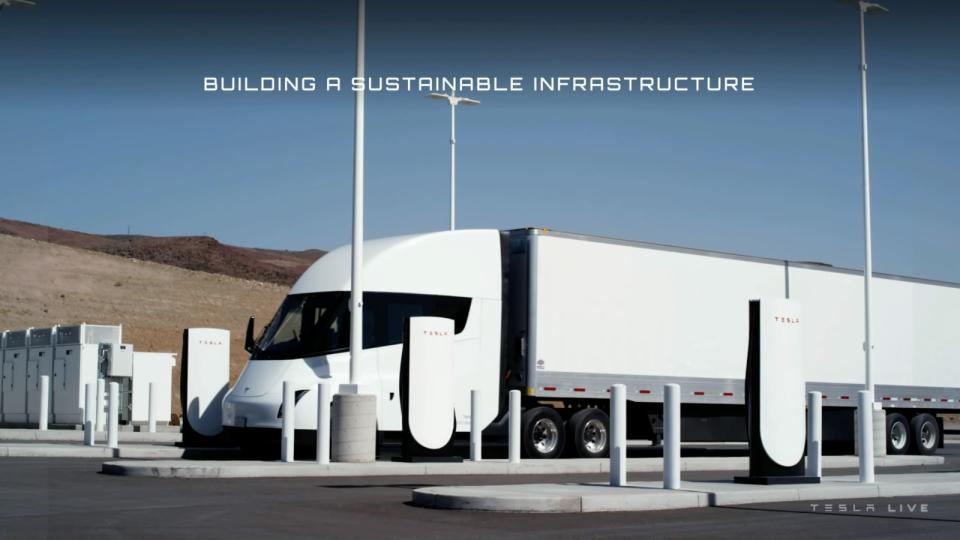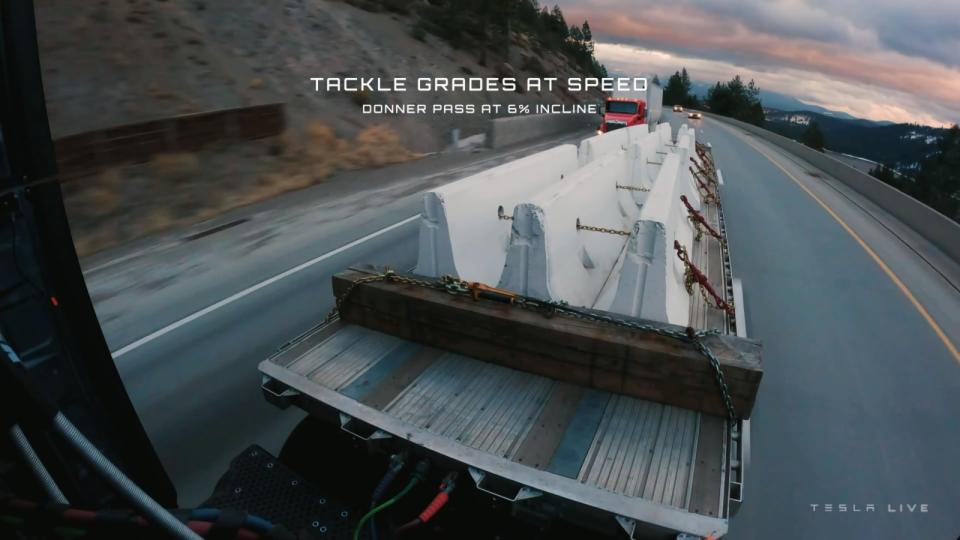Let’s talk about the Tesla Semi (again) — a trucker's take

Tesla CEO Elon Musk and Tesla Semi Senior Engineering Manager Dan Priestly took the stage last night – the stage being a flatbed trailer – to announce the arrival of the Tesla Semi. As everyone has noted, this is five years after Musk announced the Semi and three years after Musk said the Semi would enter production.
After the 2017 debut, I wrote a piece asking some questions about the rig, especially concerning some of its more unusual elements like the central seating position and doors behind the driver. I’d spent nine months of that year driving an over-the-road truck more than 70,000 miles in the United States and Canada for two companies. After last night’s presentation, most of those questions remain. But let’s consider what happened last night.
I'll start by saying congratulations to Tesla the same way I’ve congratulated every other aspiring and established automaker for getting a hot product out the door finally (such as Lordstown Motors). Making cars is hard. The times are harder.
Now to the breakdown.
“The Future of Trucking.”
– Tesla Semi web site
If the Semi ends up being the future of trucking, we won’t know for another decade or so. More importantly, the Tesla Semi as-is could only be the future of a certain kind of trucking, bringing us to the first issue we need to clear up: The word “Trucking.”
That word makes people, even truckers, think of long-haul, over-the-road tractor-trailers with drivers who sleep in truck stops and don’t see their families but once every couple of months. Those tractors are called “sleepers,” referring to the area behind the seats that contains a bed where the driver, well, you can guess what he or she does there.
The Tesla Semi is not that. The Semi is what’s called a “day cab.” This is for regional work, like moving goods between locations a few hundred miles apart. In the early mornings you’ll see day cabs delivering food and drink from local warehouses to restaurants. On interstate highways in the wee hours, you’ll probably pass or be passed by numerous FedEx day cabs running parcels from one sorting depot to another. They’re cabs and a couple of seats, often a window in back you can see the occupants through. Those drivers go home every day at the ends of their shifts.
Truckers drive thousands of miles per week all over North America and sleep in their trucks. Daycabbers drive regional routes and sleep at home. The Semi serves the latter.

“This is a step-change improvement."
– Elon Musk, December 1
This could be true, but there’s some context – and it needs on-road proof.
The Semi isn’t the first electric truck, nor is it the only one fitted with three motors. The only reason it gets so much ink is because it’s a Tesla. That’s not hate. Celebrity and industry-defining products have their perks.
But Daimler truck division Freightliner has an eCascadia Class 8 rig plus an electric school bus and an electric box truck. Nikola has its Tre BEV. Volvo-owned Renault Trucks has an even wider selection of e-rigs than Daimler, but in Europe. The Daimler can pull the same 82,000 pounds as the Tesla.
The step change would be the real-world range and the ecosystem – the unique selling proposition that made Tesla, Tesla as far back as the debut of the Model S. The eCascadia is listed with a typical range of 220 miles with tandem drivers (the two axles behind the cab) or 230 miles with a single axle in long-range configuration. Daimler’s max battery capacity is 440 kWh. The Tre BEV uses a 733-kWh battery to go 330 miles. The European Renault over-the-road T E-Tech truck can go 186 miles on a charge. The Renault’s max battery capacity is 540 kWh.
Mixing those battery figures with Tesla’s claim that the Semi uses less than 2 kWh of battery capacity per mile, it’s clear the Tesla’s packing a whole lot more battery than those other trucks.

“Not very impressive – moving a cargo of chips (average weight per pack 52 grams) cannot in any way be said to be definitive proof of concept.”
– Oliver Dixon, a senior analyst at consultancy Guidehouse, to Reuters
Fluff isn’t always positive, and I don’t understand Dixon’s complaint. Yes, we’re missing a lot of info. But PepsiCo, which owns Frito-Lay, is the Semi’s first customer. Frito-Lay makes chips. Those chips have to get from the factory to distribution centers and stores. Diesel trucks take them there. Our guess is that right now, a few Semis are on the job, too. It’s not Tesla’s fault that Frito-Lay needs to haul chips.
As for proving the concept, Musk and Priestly showed video of a Semi pulling a flatbed load of highway dividers over the Donner Pass, a 6% grade in northern California. They also showed a timelapse video of what they said was a full load of nearly 82,000 pounds being driven from Fresno to San Diego.
Pepsi weighs a lot more than Cheetos, and Pepsi knows this. The company would have nixed the deal years ago if it didn’t believe the truck could pull a bunch of Pepsi. However, until we know how much the Semi weighs, and how much of its 82,000 pounds is cargo instead of tractor, that's another asterisk after "definitive proof of concept."
Update: Not long after this piece ran, a colleague of Dixon's wrote to say, "I think the point that Oliver was trying to make there (and unfortunately we are frequently quoted with just tiny snippets out of larger comments) ... is that Tesla has said absolutely nothing about the weight of the Semi. ... The 1 MWh battery in the Semi probably weighs in the range of 12-15,000 lbs compared to about 1,200 for a diesel powertrain. Even with the extra 2,000 lbs allowed for an electric truck, you’re probably losing somewhere in the neighborhood of 10,000s of payload with this truck and the commensurate revenue that goes with it. That’s a non-trivial amount, about 20-25% depending on the weight of the truck and trailer. While a 500-mile run at 82,000 lbs is absolutely impressive, the question remains as to how much of that was cargo?"
“To have cold brakes at the bottom of the hill, that's mind-blowing in the trucking world”
– Elon Musk

 Yahoo Autos
Yahoo Autos 
